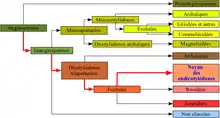Nepenthaceae
La famille monotypique des Népenthacées regroupe des plantes dicotylédones ; elle comprend au moins 86[1] espèces dans un seul genre.

| Règne | Plantae |
|---|---|
| Sous-règne | Tracheobionta |
| Division | Magnoliophyta |
| Classe | Magnoliopsida |
| Sous-classe | Dilleniidae |
| Ordre | Nepenthales |

| Clade | Angiospermes |
|---|---|
| Clade | Dicotylédones vraies |
| Clade | Noyau des Dicotylédones vraies |
| Ordre | Caryophyllales |
| Famille | Nepenthaceae |
La majeure partie sont des lianes, pouvant être épiphytes à mécanisme de capture passif, des régions tropicales : Seychelles (Nepenthes pervillei), Madagascar (Nepenthes masoalensis et Nepenthes madagascariensis), Inde (Nepenthes khasiana), péninsule indomalaise, Bornéo, Sumatra, Java, Ceylan, Australie et Nouvelle-Calédonie.
Étymologie
Le nom vient du genre type Nepenthes construction faite à partir du grec νε / ne, non, et πενθές / penthes, deuil, la « nepenthe » étant ainsi une plante censée chasser la tristesse, un antidépresseur ou une drogue de l'oubli. Le nom fut déjà utilisé dans l'Odyssée de Homère[2].
Classification
La classification phylogénétique[3] situe cette famille dans l'ordre des Caryophyllales.
Liste des genres
Selon Angiosperm Phylogeny Website (3 mai 2010)[4], NCBI (3 mai 2010)[5] et ITIS (3 mai 2010)[6] :
- genre Nepenthes L.
Selon DELTA Angio (3 mai 2010)[7] :
- genre Anurosperma
- genre Nepenthes
Le genre Anurosperma[8], monospécifique, avec Anurosperma pervillei comme seule espèce a été repositionné parmi le genre Nepenthes sous le nom Nepenthes pervillei
Liste des espèces
- genre Nepenthes
- Nepenthes adnata
- Nepenthes alata
- Nepenthes albomarginata
- Nepenthes ampullaria
- Nepenthes anamensis
- Nepenthes aristolochioides
- Nepenthes bellii
- Nepenthes benstonei
- Nepenthes bicalcarata
- Nepenthes bongso
- Nepenthes boschiana
- Nepenthes burbidgeae
- Nepenthes burkei
- Nepenthes clipeata
- Nepenthes danseri
- Nepenthes densiflora
- Nepenthes diatas
- Nepenthes distillatoria
- Nepenthes dubia
- Nepenthes edwardsiana
- Nepenthes ephippiata
- Nepenthes eustachya
- Nepenthes eymae
- Nepenthes faizaliana
- Nepenthes fusca
- Nepenthes glabrata
- Nepenthes gracilis
- Nepenthes gracillima
- Nepenthes gymnamphora
- Nepenthes hamata
- Nepenthes hirsuta
- Nepenthes inermis
- Nepenthes insignis
- Nepenthes kampotiana
- Nepenthes khasiana
- Nepenthes lamii
- Nepenthes lavicola
- Nepenthes longifolia
- Nepenthes lowii
- Nepenthes macfarlanei
- Nepenthes macrophylla
- Nepenthes macrovulgaris
- Nepenthes madagascariensis
- Nepenthes mapuluensis
- Nepenthes masoalensis
- Nepenthes maxima
- Nepenthes merrilliana
- Nepenthes mikei
- Nepenthes mira
- Nepenthes mirabilis
- Nepenthes muluensis
- Nepenthes murudensis
- Nepenthes neoguineensis
- Nepenthes northiana
- Nepenthes ovata
- Nepenthes pectinata
- Nepenthes pervillei
- Nepenthes cf. petiolata HM-2001
- Nepenthes pilosa
- Nepenthes rafflesiana
- Nepenthes rajah
- Nepenthes ramispina
- Nepenthes reinwardtiana
- Nepenthes rhombicaulis
- Nepenthes sanguinea
- Nepenthes sibuyanensis
- Nepenthes singalana
- Nepenthes smilesii
- Nepenthes spathulata
- Nepenthes spectabilis
- Nepenthes stenophylla
- Nepenthes sumatrana
- Nepenthes talangensis
- Nepenthes tentaculata
- Nepenthes thorelii
- Nepenthes tobaica
- Nepenthes tomoriana
- Nepenthes treubiana
- Nepenthes truncata
- Nepenthes veitchii
- Nepenthes ventricosa
- Nepenthes vieillardii
- Nepenthes villosa
- Nepenthes ×henryana
- Nepenthes ×intermedia
- Nepenthes ×superba
- Nepenthes xiphioides
- Nepenthes sp. 'Kosobe'
- Nepenthes sp. HHM 2001-2
- Nepenthes sp. HHM 2001-3
- Nepenthes sp. HHM-2001-1
- Nepenthes sp. HHM-2001-2
- Nepenthes sp. Jobson 1049
- Nepenthes sp. Nickrent 3056
Cultivars :
- Nepenthes 'Rebecca Soper' = Nepenthes ramispina × Nepenthes ventricosa
- Nepenthes x 'Miranda' = Nepenthes maxima x Nepenthes northiana.
Notes et références
- Cheek, M. and M. Jebb (2001). Nepenthaceae. Flora Malaysiana. Leiden, the Netherlands, Publication Department of the National Herbarium Nederland: 164 pp.
- (en) Maarten J M Christenhusz, Michael F Fay et Mark W. Chase, Plants of the World : An Illustrated Encyclopedia of Vascular Plants, Chicago, The University of Chicago Press, , 792 p. (ISBN 978-0-2265-2292-0), p. 439
- APGII (2003). "An update of the Angiosperm Phylogeny Group classification for the orders and families of flowering plants: APG II." Botanical Journal of the Linnean Society 141 399–436
- Angiosperm Phylogeny Website, consulté le 3 mai 2010
- NCBI, consulté le 3 mai 2010
- ITIS, consulté le 3 mai 2010
- DELTA Angio, consulté le 3 mai 2010
- Hook, 1921 in Cheek, M. and M. Jebb (2001) (p.1). Nepenthaceae. Flora Malaysiana. Leiden, the Netherlands, Publication Department of the National Herbarium Nederland: 164 pp.
Liens externes
- (en) Référence Flora of China : Nepenthaceae
- (en) Référence Madagascar Catalogue : Nepenthaceae
- (en) Référence Angiosperm Phylogeny Website : Nepenthaceae ()
- (en) Référence Jardin botanique du Missouri : Nepenthaceae (images de Madagascar)
- (en) Référence DELTA Angio : Nepenthaceae Dum.
- (en) Référence Tree of Life Web Project : Nepenthaceae
- (en) Référence Paleobiology Database : Nepenthaceae von Berchtold and Presl
- (fr+en) Référence ITIS : Nepenthaceae
- (en) Référence NCBI : Nepenthaceae (taxons inclus)
- (en) Référence UICN : taxon Nepenthaceae
- (en) Référence GRIN : famille Nepenthaceae Dumort. (+liste des genres contenant des synonymes)
- (fr+en) Référence CITES : famille Nepenthaceae (sur le site de l’UNEP-WCMC)
- Portail de la botanique